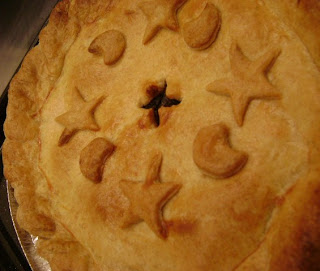 Chocolate Christmas 'card' from Miette
Chocolate Christmas 'card' from MietteDear James,
Many thanks for the fantastic Christmas dinner you delivered for my father-in-law and his mother. They both really enjoyed it and were very pleased with the generous portion sizes! For Granny to say she really enjoyed it is very hig praise indeed..... previous attempts at change have not gone well....
Many thanks, once again - a great service & wonderful food.
Yours sincerely
Jane Freeman
Pumpkin and cranberry bread rolls
Cushion of Smoked Donnington trout.
 The fish are reared in crystal clear spring water at Donnington trout farm which is free of pollution so they taste delicious, with none of the muddy flavours sometimes associated with river-farmed trout. They smoke it on site in their own smokery. Smoked trout is similar to smoked salmon but softer and more delicate.
The fish are reared in crystal clear spring water at Donnington trout farm which is free of pollution so they taste delicious, with none of the muddy flavours sometimes associated with river-farmed trout. They smoke it on site in their own smokery. Smoked trout is similar to smoked salmon but softer and more delicate.
Roast turkey ballottine - breast meat and leg meat - to see how this was made click here. 
 This was accompanied by creamed leeks & onions, honey roast parsnips and glazed roast sprouts and chestnuts as seen last year, and rosemary roast potatoes.
This was accompanied by creamed leeks & onions, honey roast parsnips and glazed roast sprouts and chestnuts as seen last year, and rosemary roast potatoes.
Chilled, the fat from the stock can be removed
 Although, for the owners of Miette themselves, as I thought they would be chocolated out by the time they closed on Christmas Eve, I made some canapé sized version of my frangipane and almond topped mince pies for their Christmas lunch delivery:
Although, for the owners of Miette themselves, as I thought they would be chocolated out by the time they closed on Christmas Eve, I made some canapé sized version of my frangipane and almond topped mince pies for their Christmas lunch delivery:
Related posts:
Christmas menu
Christmas 2007
Sunday lunch in the Cotswolds


 Sadly, after the sudden death of Bob Buckingham in November, his wife, Elizabeth, was understandably under severe pressure this Christmas at the
Sadly, after the sudden death of Bob Buckingham in November, his wife, Elizabeth, was understandably under severe pressure this Christmas at the 


 4. You trim down the very top of the breast bone - where it is connectd to the skin. This removes the carcass which goes into a roasting tin, then the bones are roasted before being added to the stock pot (for more stock/ sauce info see
4. You trim down the very top of the breast bone - where it is connectd to the skin. This removes the carcass which goes into a roasting tin, then the bones are roasted before being added to the stock pot (for more stock/ sauce info see 


 8. Then you can put back the turkey beast, turning one round so you have a thick end to a thin end. Roll it and tie up string:
8. Then you can put back the turkey beast, turning one round so you have a thick end to a thin end. Roll it and tie up string: Here it is placed on a potato trivet - potato, lemon and thyme, so the lemon and thyme aromas would be going up into the turkey as it cooked, and the butter and thyme would be basting it from the top.
Here it is placed on a potato trivet - potato, lemon and thyme, so the lemon and thyme aromas would be going up into the turkey as it cooked, and the butter and thyme would be basting it from the top.



 5. Stuffing, here is sausagemeat, aricots, spices and fresh herbs:
5. Stuffing, here is sausagemeat, aricots, spices and fresh herbs: 6. To hold the stuffing in place, I add a piece of the reserved wing meat (see 6 above) to make up for the small amount of skin:
6. To hold the stuffing in place, I add a piece of the reserved wing meat (see 6 above) to make up for the small amount of skin: 7. Then they are rolled, tied and roasted:
7. Then they are rolled, tied and roasted:










 As we’d all be tucking into our roast beef on a Sunday afternoon (vegetables dug from the garden earlier that morning), my grandad (a Yorkshireman born and bred) would have just 2 or 3 yorkshire puddings on his plate, maybe a little gravy if he was feeling decadent. For that was the origin of the Yorkshire pudding – you ate them before anything else to fill you up so you would eat less meat – which just shows how times change. And in the days before electricity and central heating, they needed something to keep out the cold.
As we’d all be tucking into our roast beef on a Sunday afternoon (vegetables dug from the garden earlier that morning), my grandad (a Yorkshireman born and bred) would have just 2 or 3 yorkshire puddings on his plate, maybe a little gravy if he was feeling decadent. For that was the origin of the Yorkshire pudding – you ate them before anything else to fill you up so you would eat less meat – which just shows how times change. And in the days before electricity and central heating, they needed something to keep out the cold. 5 – Hot oil. Lard seems to have gone out of fashion these days for health reasons, but it does produce the best Yorkshire puddings. Add your oil/ lard to the Yorkshire tins and heat in the oven for 10 – 15 minutes till very hot, before you add your batter mix. The oil should sizzle and start to cook the puddings as soon as the batter mix is dropped into it. Put the yorkshire pud tin on a baking tray so any oil that spills out is collected on the tray – instead of dripping on the bottom of the oven where it starts burning and fills your kitchen with smoke.
5 – Hot oil. Lard seems to have gone out of fashion these days for health reasons, but it does produce the best Yorkshire puddings. Add your oil/ lard to the Yorkshire tins and heat in the oven for 10 – 15 minutes till very hot, before you add your batter mix. The oil should sizzle and start to cook the puddings as soon as the batter mix is dropped into it. Put the yorkshire pud tin on a baking tray so any oil that spills out is collected on the tray – instead of dripping on the bottom of the oven where it starts burning and fills your kitchen with smoke.


 Fillet steak seared on the grill pan, then finished in the oven for 8 - 10 minutes, is here resting after cooking....
Fillet steak seared on the grill pan, then finished in the oven for 8 - 10 minutes, is here resting after cooking....




 Half a baking potato just does one portion – so it’s an idea to have a another one as spare. Salt it quite well, then leave it to macerate for 10 - 20 minutes. The salt brings out the water.
Half a baking potato just does one portion – so it’s an idea to have a another one as spare. Salt it quite well, then leave it to macerate for 10 - 20 minutes. The salt brings out the water. Then you fry them like my
Then you fry them like my 










